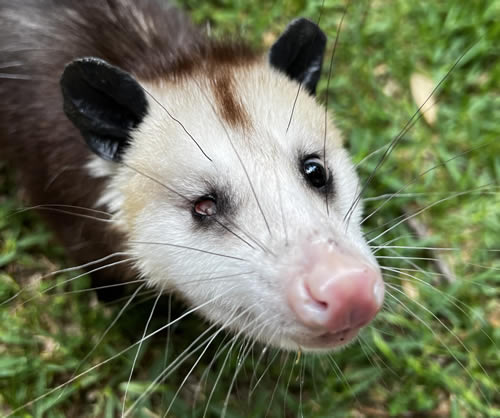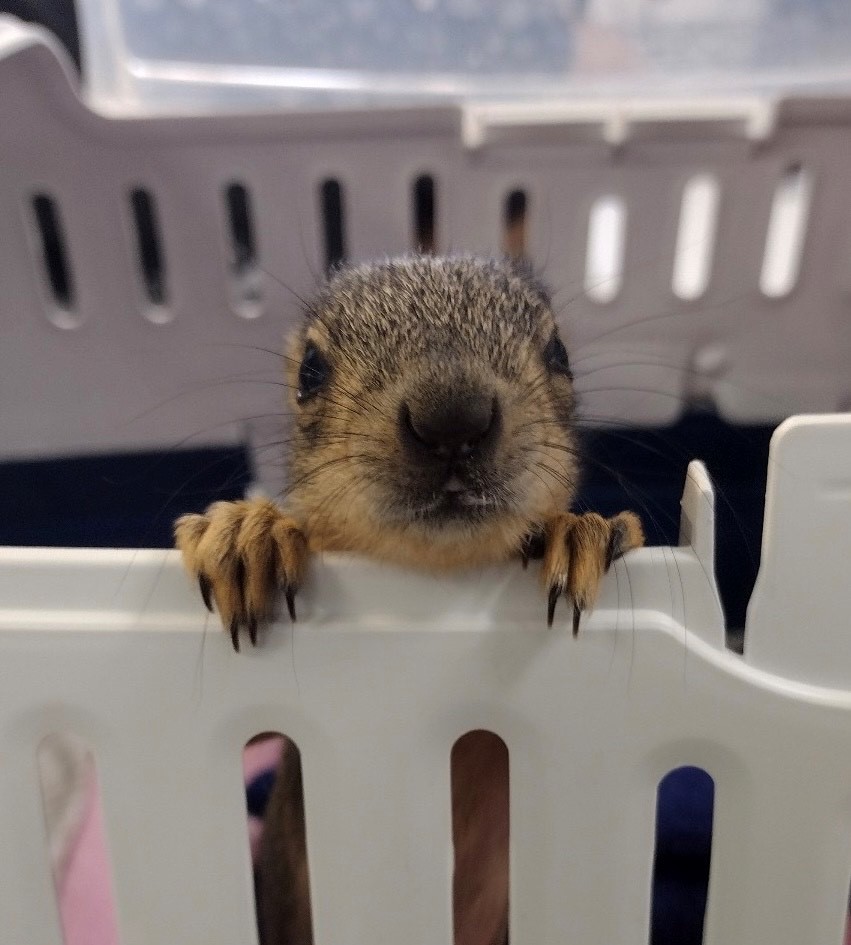By Amber Leung, Certified Texas Master Naturalist
As the weather warms up, more of our wildlife is on the move. This can include, to the fascination or horror of some: snakes! There is some good news about this fact: snakes provide free pest control services and the majority of them are mostly harmless to people and pets.
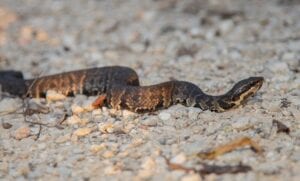
There are a few dangerous species in our area but by following a few guidelines, and doing little bit of preparation, we can all find ways to coexist safely and peacefully.
Stay Snake Safe!
- Never place your hands or feet into any place you can’t see. Check under shrubs or around planters and landscaping before reaching in with your hand. Look where you step and wear closed-toed shoes, especially if you’re in tall grass.
- Venomous bites often occur when people are purposely interacting with snakes. Never handle one unless you are 100% sure of the species. Accidents can also happen when a person is trying to kill unwelcome snakes, instead you can get it to move out of the area with a blast of water from a garden hose.
- Chemical snake deterrents are not effective, no matter what the advertisements claim. Instead, you can discourage snakes by not providing a good habitat for them. Do this by keeping the yard clear of debris, avoid high grass, and remove anything that could attract rodents (the food of choice of many snakes). If you do see rodent droppings, try setting some traps. Rodent poison may be a poor option, as it sometimes kills protected species such as our resident owls and hawks.
- Outdoor cats are sometimes touted as a solution to snakes, but this puts them at high risk of injury or even death from road traffic, coyotes, parasites, and disease. Cats do not need outdoor time, and they live far longer when they are cared for indoors.
- For difficult situations or venomous species, sometimes the best course of action is to call a professional or skilled volunteer to capture and remove snakes using the appropriate safety equipment.
There are some identification tricks that are commonly repeated about venomous snakes in the USA, but they may not be as helpful as promised. Like many things in life, there are no true shortcuts to knowledge and safety! Instead, it’s better to devote some time to study the identifying features of your local species ahead of time, especially if you’re feeling anxious about your scaly neighbors.
Triangular heads
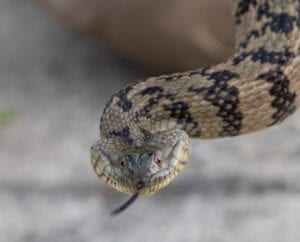
Calling the heads of venomous snakes “triangular” is an oversimplification. Nonvenomous water snakes and rat snakes are very convincing mimics of venomous species because they will flatten their heads into a wide triangle shape when they feel threatened. For this reason, head shape can be unreliable and should only be used in combination with several other features.
Cat eyes
Rattlesnakes, copperheads, and cottonmouths have vertical-slit pupils, while coralsnakes do not. The size and shape of these pupils can change in low light and may sometimes appear nearly round. While it’s easy to see the pupils in a quality photograph, spotting them in person (and from a safe distance) is another story.
We have an impressive diversity of snakes in the Greater Houston region. Out of these, only a few are venomous. Taking a little extra time to study these few species can go a long way toward training your eyes to see and recognize them. Do not rely on a Google search, internet sources are notoriously unreliable. Instead, invest in a quality field guide for our area.
Copperhead and Cottonmouth
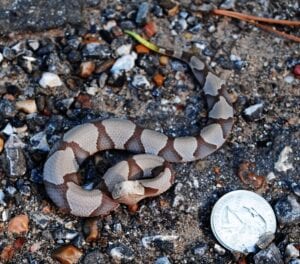
Some of the most common venomous snakes likely to be found in our area are Northern cottonmouths (Agkistrodon piscivorus) and Eastern copperheads (Agkistrodon contortrix). They share many similarities because they are, in fact, closely related! While their heads could be described as “triangular,” this single feature isn’t a reliable way to identify them. They also have vertical-slit pupils (or “cat eyes”), but this is not easily observed from a safe distance.
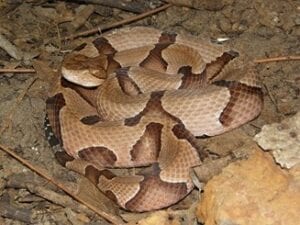
Copperheads come in shades of tan and brown. Their pattern might vary, but usually consists of smooth triangles that may resemble Hershey’s kisses from the side, or hourglasses when seen from above. Their camouflage is most effective around piles of dry leaves, sometimes rendering them nearly invisible. Cottonmouths may have similar coloration as copperheads when they are young, but their tan colors darken to brown or nearly black in older snakes. Their pattern has a jagged, almost “pixelated” appearance, but it is not always visible. They also have a dark bandit mask across the sides of their head. For both these species, very young individuals also have bright yellow-green tail-tips, which are used like a lure to attract prey. This is called a caudal lure.
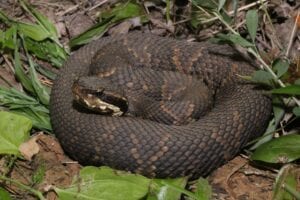
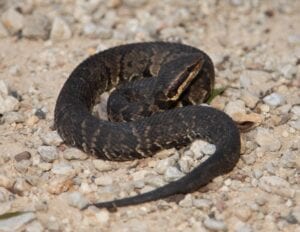
Texas Coralsnake
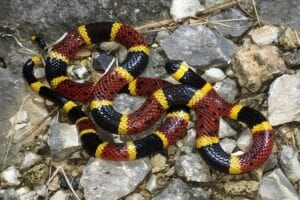
Texas coralsnakes (Micrurus tener) are shy and tend to flee when harassed. They may also curl up the end of their tails and “strike” with it to trick a predator into thinking their dangerous head is on the other end! They have short, fixed fangs in their small mouths and a small amount of neurotoxic venom. Despite some myths, they are fully capable of opening wide enough to bite and quickly envenomate any part of a person or animal. Even so, there has never been a single recorded human death from a Texas coralsnake bite!
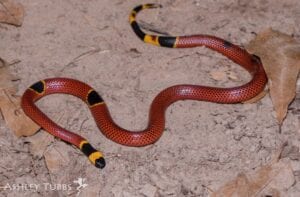
Their color pattern usually goes from yellow, red, yellow, black, before repeating. This is the basis of the “red touch yellow” rhyme that people often repeat to help differentiate a venomous coralsnake from a harmless milksnake. Take care not to rely too heavily on this, because coralsnakes often break their own rules! This is called “aberrant coloration”. The best rule to follow is to simply leave any colorful snake alone if you don’t know them very well.
Rattlesnakes
Rattlesnakes are less likely to be found in our immediate area. Western diamond-backed rattlesnakes (Crotalus atrox) commonly inhabit the sand dunes along the coast and to the West near Bastrop. Timber rattlesnakes (Crotalus horridus) are found in the piney woods areas to the north of Houston as well as west around Columbus. Rattlesnakes can deliver large quantities of potent venom and should be treated with great respect at all times.
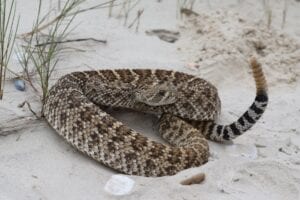
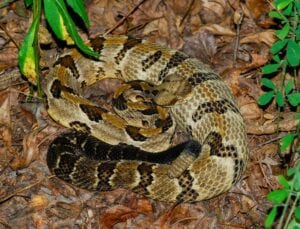
Watersnakes
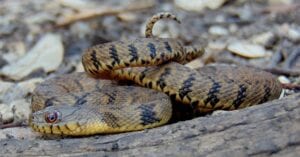
With our many lakes and plentiful fish and frogs, it’s little wonder that some of the most commonly-encountered snakes in the community are nonvenomous watersnakes. As you might guess, they primarily feed on small fish, frogs, and toads. These are mostly representatives of three closely-related species: diamond-backed watersnake (Nerodia rhombifer), plain-bellied watersnake (Nerodia erythrogaster), and broad-banded watersnake (Nerodia fasciata confluens).
They are often mistaken for venomous cottonmouths, but take note of the vertical bars along their jaws, which is one excellent way to differentiate them. Diamond-backed watersnakes are the largest of the three. Their pattern has diamond shapes on the top, which can sometimes resemble a chain-link fence. Next, the plain-bellied watersnake often has a bright and bold pattern when young. As they age, it may darken until it is nearly invisible. The broadbanded watersnake is visually-striking, with irregular bands in shades of black, brown, and orange.
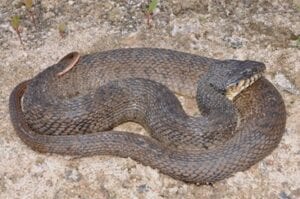
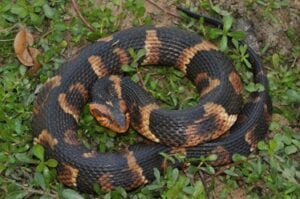
Dekay’s brownsnake and rough earthsnake
With your garden often comes a few tiny species that are often falsely accused of being baby copperheads. These are the Dekay’s brownsnake (Storeria dekayi) and the rough earthsnake (Haldea striatula). They both average less than a foot in length and are nonvenomous and beneficial garden guests who feed on bugs and slugs.

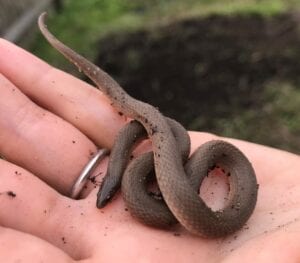
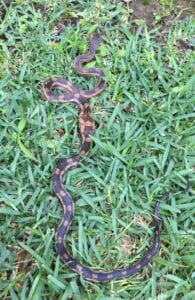
Western ratsnake
Our local rodent-hunting specialist, the Western ratsnake (Pantherophis obsoletus) is also known to swallow chicken eggs, and is a very capable climber. Rat snakes are slim-bodied, adults can be 3 to 6 feet long. Although their coloration and patterns can vary, they generally have brown patches down the length of their backs that resemble a saddle in shape.
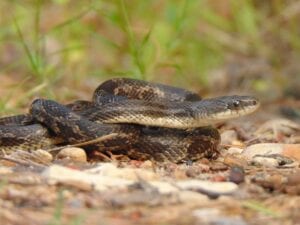
For more information, you can find a laminated quick reference guide by Clint Pustejovsky entitled “Snakes of Southeast Texas” in local grocery and sporting goods stores. There are also a number of educational groups on social media devoted to fast and accurate snake identification. One can also get a reliable identification on a snake photo by uploading it to the citizen science website iNaturalist.org. Left to do their important pest-control work, snakes are a beneficial part of the urban ecosystem.

